
text-embeddings-inference
A blazing fast inference solution for text embeddings models
Stars: 3989
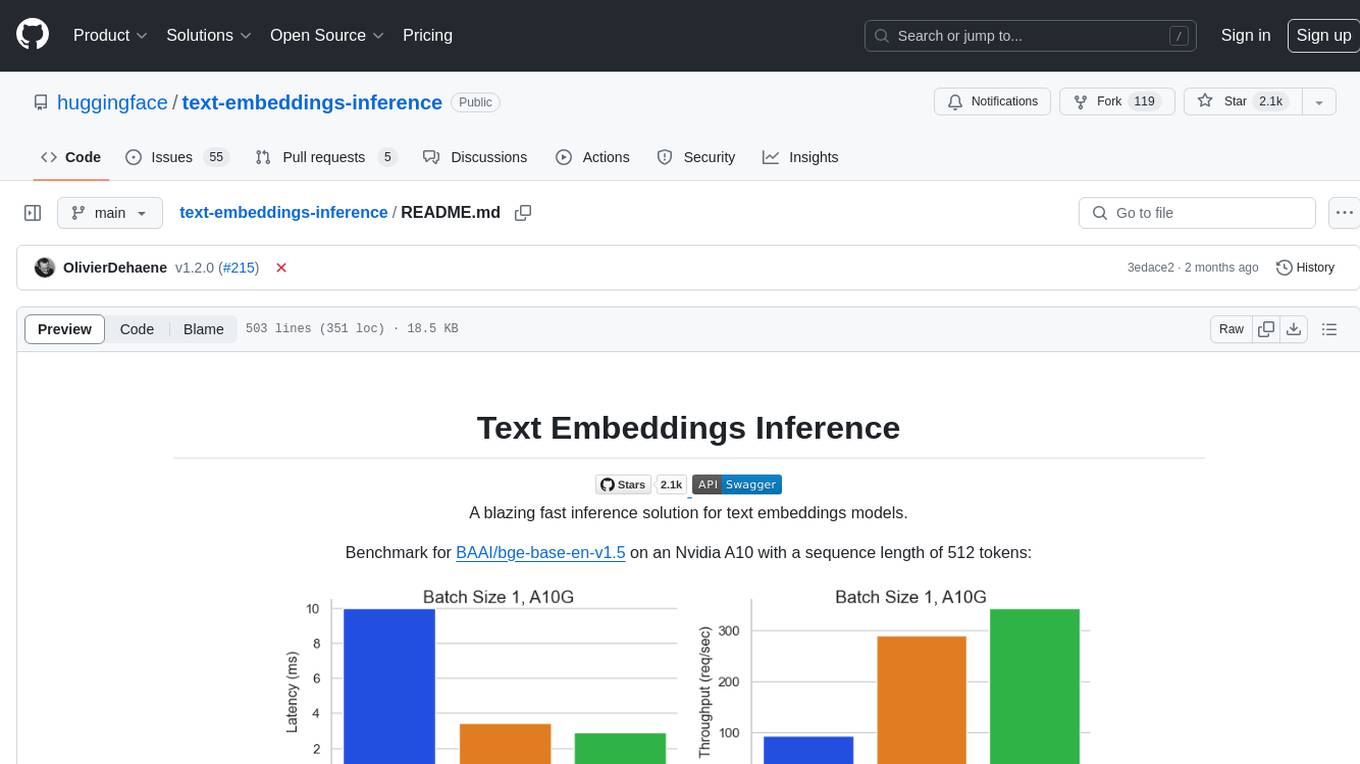
Text Embeddings Inference (TEI) is a toolkit for deploying and serving open source text embeddings and sequence classification models. TEI enables high-performance extraction for popular models like FlagEmbedding, Ember, GTE, and E5. It implements features such as no model graph compilation step, Metal support for local execution on Macs, small docker images with fast boot times, token-based dynamic batching, optimized transformers code for inference using Flash Attention, Candle, and cuBLASLt, Safetensors weight loading, and production-ready features like distributed tracing with Open Telemetry and Prometheus metrics.
README:


A blazing fast inference solution for text embeddings models.
Benchmark for BAAI/bge-base-en-v1.5 on an Nvidia A10 with a sequence length of 512 tokens:
Text Embeddings Inference (TEI) is a toolkit for deploying and serving open source text embeddings and sequence classification models. TEI enables high-performance extraction for the most popular models, including FlagEmbedding, Ember, GTE and E5. TEI implements many features such as:
- No model graph compilation step
- Metal support for local execution on Macs
- Small docker images and fast boot times. Get ready for true serverless!
- Token based dynamic batching
- Optimized transformers code for inference using Flash Attention, Candle and cuBLASLt
- Safetensors weight loading
- ONNX weight loading
- Production ready (distributed tracing with Open Telemetry, Prometheus metrics)
Text Embeddings Inference currently supports Nomic, BERT, CamemBERT, XLM-RoBERTa models with absolute positions, JinaBERT model with Alibi positions and Mistral, Alibaba GTE, Qwen2 models with Rope positions, MPNet, ModernBERT, and Qwen3.
Below are some examples of the currently supported models:
| MTEB Rank | Model Size | Model Type | Model ID |
|---|---|---|---|
| 2 | 8B (Very Expensive) | Qwen3 | Qwen/Qwen3-Embedding-8B |
| 4 | 0.6B | Qwen3 | Qwen/Qwen3-Embedding-0.6B |
| 6 | 7B (Very Expensive) | Qwen2 | Alibaba-NLP/gte-Qwen2-7B-instruct |
| 7 | 0.5B | XLM-RoBERTa | intfloat/multilingual-e5-large-instruct |
| 14 | 1.5B (Expensive) | Qwen2 | Alibaba-NLP/gte-Qwen2-1.5B-instruct |
| 17 | 7B (Very Expensive) | Mistral | Salesforce/SFR-Embedding-2_R |
| 34 | 0.5B | XLM-RoBERTa | Snowflake/snowflake-arctic-embed-l-v2.0 |
| 40 | 0.3B | Alibaba GTE | Snowflake/snowflake-arctic-embed-m-v2.0 |
| 51 | 0.3B | Bert | WhereIsAI/UAE-Large-V1 |
| N/A | 0.4B | Alibaba GTE | Alibaba-NLP/gte-large-en-v1.5 |
| N/A | 0.4B | ModernBERT | answerdotai/ModernBERT-large |
| N/A | 0.3B | NomicBert | nomic-ai/nomic-embed-text-v2-moe |
| N/A | 0.1B | NomicBert | nomic-ai/nomic-embed-text-v1 |
| N/A | 0.1B | NomicBert | nomic-ai/nomic-embed-text-v1.5 |
| N/A | 0.1B | JinaBERT | jinaai/jina-embeddings-v2-base-en |
| N/A | 0.1B | JinaBERT | jinaai/jina-embeddings-v2-base-code |
| N/A | 0.1B | MPNet | sentence-transformers/all-mpnet-base-v2 |
To explore the list of best performing text embeddings models, visit the Massive Text Embedding Benchmark (MTEB) Leaderboard.
Text Embeddings Inference currently supports CamemBERT, and XLM-RoBERTa Sequence Classification models with absolute positions.
Below are some examples of the currently supported models:
| Task | Model Type | Model ID |
|---|---|---|
| Re-Ranking | XLM-RoBERTa | BAAI/bge-reranker-large |
| Re-Ranking | XLM-RoBERTa | BAAI/bge-reranker-base |
| Re-Ranking | GTE | Alibaba-NLP/gte-multilingual-reranker-base |
| Re-Ranking | ModernBert | Alibaba-NLP/gte-reranker-modernbert-base |
| Sentiment Analysis | RoBERTa | SamLowe/roberta-base-go_emotions |
model=Qwen/Qwen3-Embedding-0.6B
volume=$PWD/data # share a volume with the Docker container to avoid downloading weights every run
docker run --gpus all -p 8080:80 -v $volume:/data --pull always ghcr.io/huggingface/text-embeddings-inference:1.8 --model-id $modelAnd then you can make requests like
curl 127.0.0.1:8080/embed \
-X POST \
-d '{"inputs":"What is Deep Learning?"}' \
-H 'Content-Type: application/json'Note: To use GPUs, you need to install the NVIDIA Container Toolkit. NVIDIA drivers on your machine need to be compatible with CUDA version 12.2 or higher.
To see all options to serve your models:
$ text-embeddings-router --help
Text Embedding Webserver
Usage: text-embeddings-router [OPTIONS]
Options:
--model-id <MODEL_ID>
The name of the model to load. Can be a MODEL_ID as listed on <https://hf.co/models> like `BAAI/bge-large-en-v1.5`. Or it can be a local directory containing the necessary files as saved by `save_pretrained(...)` methods of transformers
[env: MODEL_ID=]
[default: BAAI/bge-large-en-v1.5]
--revision <REVISION>
The actual revision of the model if you're referring to a model on the hub. You can use a specific commit id or a branch like `refs/pr/2`
[env: REVISION=]
--tokenization-workers <TOKENIZATION_WORKERS>
Optionally control the number of tokenizer workers used for payload tokenization, validation and truncation. Default to the number of CPU cores on the machine
[env: TOKENIZATION_WORKERS=]
--dtype <DTYPE>
The dtype to be forced upon the model
[env: DTYPE=]
[possible values: float16, float32]
--pooling <POOLING>
Optionally control the pooling method for embedding models.
If `pooling` is not set, the pooling configuration will be parsed from the model `1_Pooling/config.json` configuration.
If `pooling` is set, it will override the model pooling configuration
[env: POOLING=]
Possible values:
- cls: Select the CLS token as embedding
- mean: Apply Mean pooling to the model embeddings
- splade: Apply SPLADE (Sparse Lexical and Expansion) to the model embeddings. This option is only available if the loaded model is a `ForMaskedLM` Transformer model
- last-token: Select the last token as embedding
--max-concurrent-requests <MAX_CONCURRENT_REQUESTS>
The maximum amount of concurrent requests for this particular deployment. Having a low limit will refuse clients requests instead of having them wait for too long and is usually good to handle backpressure correctly
[env: MAX_CONCURRENT_REQUESTS=]
[default: 512]
--max-batch-tokens <MAX_BATCH_TOKENS>
**IMPORTANT** This is one critical control to allow maximum usage of the available hardware.
This represents the total amount of potential tokens within a batch.
For `max_batch_tokens=1000`, you could fit `10` queries of `total_tokens=100` or a single query of `1000` tokens.
Overall this number should be the largest possible until the model is compute bound. Since the actual memory overhead depends on the model implementation, text-embeddings-inference cannot infer this number automatically.
[env: MAX_BATCH_TOKENS=]
[default: 16384]
--max-batch-requests <MAX_BATCH_REQUESTS>
Optionally control the maximum number of individual requests in a batch
[env: MAX_BATCH_REQUESTS=]
--max-client-batch-size <MAX_CLIENT_BATCH_SIZE>
Control the maximum number of inputs that a client can send in a single request
[env: MAX_CLIENT_BATCH_SIZE=]
[default: 32]
--auto-truncate
Automatically truncate inputs that are longer than the maximum supported size
Unused for gRPC servers
[env: AUTO_TRUNCATE=]
--default-prompt-name <DEFAULT_PROMPT_NAME>
The name of the prompt that should be used by default for encoding. If not set, no prompt will be applied.
Must be a key in the `sentence-transformers` configuration `prompts` dictionary.
For example if ``default_prompt_name`` is "query" and the ``prompts`` is {"query": "query: ", ...}, then the sentence "What is the capital of France?" will be encoded as "query: What is the capital of France?" because the prompt text will be prepended before any text to encode.
The argument '--default-prompt-name <DEFAULT_PROMPT_NAME>' cannot be used with '--default-prompt <DEFAULT_PROMPT>`
[env: DEFAULT_PROMPT_NAME=]
--default-prompt <DEFAULT_PROMPT>
The prompt that should be used by default for encoding. If not set, no prompt will be applied.
For example if ``default_prompt`` is "query: " then the sentence "What is the capital of France?" will be encoded as "query: What is the capital of France?" because the prompt text will be prepended before any text to encode.
The argument '--default-prompt <DEFAULT_PROMPT>' cannot be used with '--default-prompt-name <DEFAULT_PROMPT_NAME>`
[env: DEFAULT_PROMPT=]
--dense-path <DENSE_PATH>
Optionally, define the path to the Dense module required for some embedding models.
Some embedding models require an extra `Dense` module which contains a single Linear layer and an activation function. By default, those `Dense` modules are stored under the `2_Dense` directory, but there might be cases where different `Dense` modules are provided, to convert the pooled embeddings into different dimensions, available as `2_Dense_<dims>` e.g. https://huggingface.co/NovaSearch/stella_en_400M_v5.
Note that this argument is optional, only required to be set if the path to the `Dense` module is other than `2_Dense`. And it also applies when leveraging the `candle` backend.
[env: DENSE_PATH=]
[default: 2_Dense]
--hf-token <HF_TOKEN>
Your Hugging Face Hub token
[env: HF_TOKEN=]
--hostname <HOSTNAME>
The IP address to listen on
[env: HOSTNAME=]
[default: 0.0.0.0]
-p, --port <PORT>
The port to listen on
[env: PORT=]
[default: 3000]
--uds-path <UDS_PATH>
The name of the unix socket some text-embeddings-inference backends will use as they communicate internally with gRPC
[env: UDS_PATH=]
[default: /tmp/text-embeddings-inference-server]
--huggingface-hub-cache <HUGGINGFACE_HUB_CACHE>
The location of the huggingface hub cache. Used to override the location if you want to provide a mounted disk for instance
[env: HUGGINGFACE_HUB_CACHE=]
--payload-limit <PAYLOAD_LIMIT>
Payload size limit in bytes
Default is 2MB
[env: PAYLOAD_LIMIT=]
[default: 2000000]
--api-key <API_KEY>
Set an api key for request authorization.
By default the server responds to every request. With an api key set, the requests must have the Authorization header set with the api key as Bearer token.
[env: API_KEY=]
--json-output
Outputs the logs in JSON format (useful for telemetry)
[env: JSON_OUTPUT=]
--disable-spans
[env: DISABLE_SPANS=]
--otlp-endpoint <OTLP_ENDPOINT>
The grpc endpoint for opentelemetry. Telemetry is sent to this endpoint as OTLP over gRPC. e.g. `http://localhost:4317`
[env: OTLP_ENDPOINT=]
--otlp-service-name <OTLP_SERVICE_NAME>
The service name for opentelemetry. e.g. `text-embeddings-inference.server`
[env: OTLP_SERVICE_NAME=]
[default: text-embeddings-inference.server]
--prometheus-port <PROMETHEUS_PORT>
The Prometheus port to listen on
[env: PROMETHEUS_PORT=]
[default: 9000]
--cors-allow-origin <CORS_ALLOW_ORIGIN>
Unused for gRPC servers
[env: CORS_ALLOW_ORIGIN=]
-h, --help
Print help (see a summary with '-h')
-V, --version
Print versionText Embeddings Inference ships with multiple Docker images that you can use to target a specific backend:
| Architecture | Image |
|---|---|
| CPU | ghcr.io/huggingface/text-embeddings-inference:cpu-1.8 |
| Volta | NOT SUPPORTED |
| Turing (T4, RTX 2000 series, ...) | ghcr.io/huggingface/text-embeddings-inference:turing-1.8 (experimental) |
| Ampere 80 (A100, A30) | ghcr.io/huggingface/text-embeddings-inference:1.8 |
| Ampere 86 (A10, A40, ...) | ghcr.io/huggingface/text-embeddings-inference:86-1.8 |
| Ada Lovelace (RTX 4000 series, ...) | ghcr.io/huggingface/text-embeddings-inference:89-1.8 |
| Hopper (H100) | ghcr.io/huggingface/text-embeddings-inference:hopper-1.8 (experimental) |
Warning: Flash Attention is turned off by default for the Turing image as it suffers from precision issues.
You can turn Flash Attention v1 ON by using the USE_FLASH_ATTENTION=True environment variable.
You can consult the OpenAPI documentation of the text-embeddings-inference REST API using the /docs route.
The Swagger UI is also available
at: https://huggingface.github.io/text-embeddings-inference.
You have the option to utilize the HF_TOKEN environment variable for configuring the token employed by
text-embeddings-inference. This allows you to gain access to protected resources.
For example:
- Go to https://huggingface.co/settings/tokens
- Copy your cli READ token
- Export
HF_TOKEN=<your cli READ token>
or with Docker:
model=<your private model>
volume=$PWD/data # share a volume with the Docker container to avoid downloading weights every run
token=<your cli READ token>
docker run --gpus all -e HF_TOKEN=$token -p 8080:80 -v $volume:/data --pull always ghcr.io/huggingface/text-embeddings-inference:1.8 --model-id $modelTo deploy Text Embeddings Inference in an air-gapped environment, first download the weights and then mount them inside the container using a volume.
For example:
# (Optional) create a `models` directory
mkdir models
cd models
# Make sure you have git-lfs installed (https://git-lfs.com)
git lfs install
git clone https://huggingface.co/Qwen/Qwen3-Embedding-0.6B
# Set the models directory as the volume path
volume=$PWD
# Mount the models directory inside the container with a volume and set the model ID
docker run --gpus all -p 8080:80 -v $volume:/data --pull always ghcr.io/huggingface/text-embeddings-inference:1.8 --model-id /data/Qwen3-Embedding-0.6Btext-embeddings-inference v0.4.0 added support for CamemBERT, RoBERTa, XLM-RoBERTa, and GTE Sequence Classification models.
Re-rankers models are Sequence Classification cross-encoders models with a single class that scores the similarity
between a query and a text.
See this blogpost by the LlamaIndex team to understand how you can use re-rankers models in your RAG pipeline to improve downstream performance.
model=BAAI/bge-reranker-large
volume=$PWD/data # share a volume with the Docker container to avoid downloading weights every run
docker run --gpus all -p 8080:80 -v $volume:/data --pull always ghcr.io/huggingface/text-embeddings-inference:1.8 --model-id $modelAnd then you can rank the similarity between a query and a list of texts with:
curl 127.0.0.1:8080/rerank \
-X POST \
-d '{"query": "What is Deep Learning?", "texts": ["Deep Learning is not...", "Deep learning is..."]}' \
-H 'Content-Type: application/json'You can also use classic Sequence Classification models like SamLowe/roberta-base-go_emotions:
model=SamLowe/roberta-base-go_emotions
volume=$PWD/data # share a volume with the Docker container to avoid downloading weights every run
docker run --gpus all -p 8080:80 -v $volume:/data --pull always ghcr.io/huggingface/text-embeddings-inference:1.8 --model-id $modelOnce you have deployed the model you can use the predict endpoint to get the emotions most associated with an input:
curl 127.0.0.1:8080/predict \
-X POST \
-d '{"inputs":"I like you."}' \
-H 'Content-Type: application/json'You can choose to activate SPLADE pooling for Bert and Distilbert MaskedLM architectures:
model=naver/efficient-splade-VI-BT-large-query
volume=$PWD/data # share a volume with the Docker container to avoid downloading weights every run
docker run --gpus all -p 8080:80 -v $volume:/data --pull always ghcr.io/huggingface/text-embeddings-inference:1.8 --model-id $model --pooling spladeOnce you have deployed the model you can use the /embed_sparse endpoint to get the sparse embedding:
curl 127.0.0.1:8080/embed_sparse \
-X POST \
-d '{"inputs":"I like you."}' \
-H 'Content-Type: application/json'text-embeddings-inference is instrumented with distributed tracing using OpenTelemetry. You can use this feature
by setting the address to an OTLP collector with the --otlp-endpoint argument.
text-embeddings-inference offers a gRPC API as an alternative to the default HTTP API for high performance
deployments. The API protobuf definition can be
found here.
You can use the gRPC API by adding the -grpc tag to any TEI Docker image. For example:
model=Qwen/Qwen3-Embedding-0.6B
volume=$PWD/data # share a volume with the Docker container to avoid downloading weights every run
docker run --gpus all -p 8080:80 -v $volume:/data --pull always ghcr.io/huggingface/text-embeddings-inference:1.8-grpc --model-id $modelgrpcurl -d '{"inputs": "What is Deep Learning"}' -plaintext 0.0.0.0:8080 tei.v1.Embed/EmbedYou can also opt to install text-embeddings-inference locally.
First install Rust:
curl --proto '=https' --tlsv1.2 -sSf https://sh.rustup.rs | shThen run:
# On x86 with ONNX backend (recommended)
cargo install --path router -F ort
# On x86 with Intel backend
cargo install --path router -F mkl
# On M1 or M2
cargo install --path router -F metalYou can now launch Text Embeddings Inference on CPU with:
model=Qwen/Qwen3-Embedding-0.6B
text-embeddings-router --model-id $model --port 8080Note: on some machines, you may also need the OpenSSL libraries and gcc. On Linux machines, run:
sudo apt-get install libssl-dev gcc -yGPUs with CUDA compute capabilities < 7.5 are not supported (V100, Titan V, GTX 1000 series, ...).
Make sure you have CUDA and the nvidia drivers installed. NVIDIA drivers on your device need to be compatible with CUDA version 12.2 or higher. You also need to add the nvidia binaries to your path:
export PATH=$PATH:/usr/local/cuda/binThen run:
# This can take a while as we need to compile a lot of cuda kernels
# On Turing GPUs (T4, RTX 2000 series ... )
cargo install --path router -F candle-cuda-turing -F http --no-default-features
# On Ampere and Hopper
cargo install --path router -F candle-cuda -F http --no-default-featuresYou can now launch Text Embeddings Inference on GPU with:
model=Qwen/Qwen3-Embedding-0.6B
text-embeddings-router --model-id $model --port 8080You can build the CPU container with:
docker build .To build the CUDA containers, you need to know the compute cap of the GPU you will be using at runtime.
Then you can build the container with:
# Get submodule dependencies
git submodule update --init
# Example for Turing (T4, RTX 2000 series, ...)
runtime_compute_cap=75
# Example for A100
runtime_compute_cap=80
# Example for A10
runtime_compute_cap=86
# Example for Ada Lovelace (RTX 4000 series, ...)
runtime_compute_cap=89
# Example for H100
runtime_compute_cap=90
docker build . -f Dockerfile-cuda --build-arg CUDA_COMPUTE_CAP=$runtime_compute_capAs explained here MPS-Ready, ARM64 Docker Image, Metal / MPS is not supported via Docker. As such inference will be CPU bound and most likely pretty slow when using this docker image on an M1/M2 ARM CPU.
docker build . -f Dockerfile --platform=linux/arm64
For Tasks:
Click tags to check more tools for each tasksFor Jobs:
Alternative AI tools for text-embeddings-inference
Similar Open Source Tools

text-embeddings-inference
Text Embeddings Inference (TEI) is a toolkit for deploying and serving open source text embeddings and sequence classification models. TEI enables high-performance extraction for popular models like FlagEmbedding, Ember, GTE, and E5. It implements features such as no model graph compilation step, Metal support for local execution on Macs, small docker images with fast boot times, token-based dynamic batching, optimized transformers code for inference using Flash Attention, Candle, and cuBLASLt, Safetensors weight loading, and production-ready features like distributed tracing with Open Telemetry and Prometheus metrics.
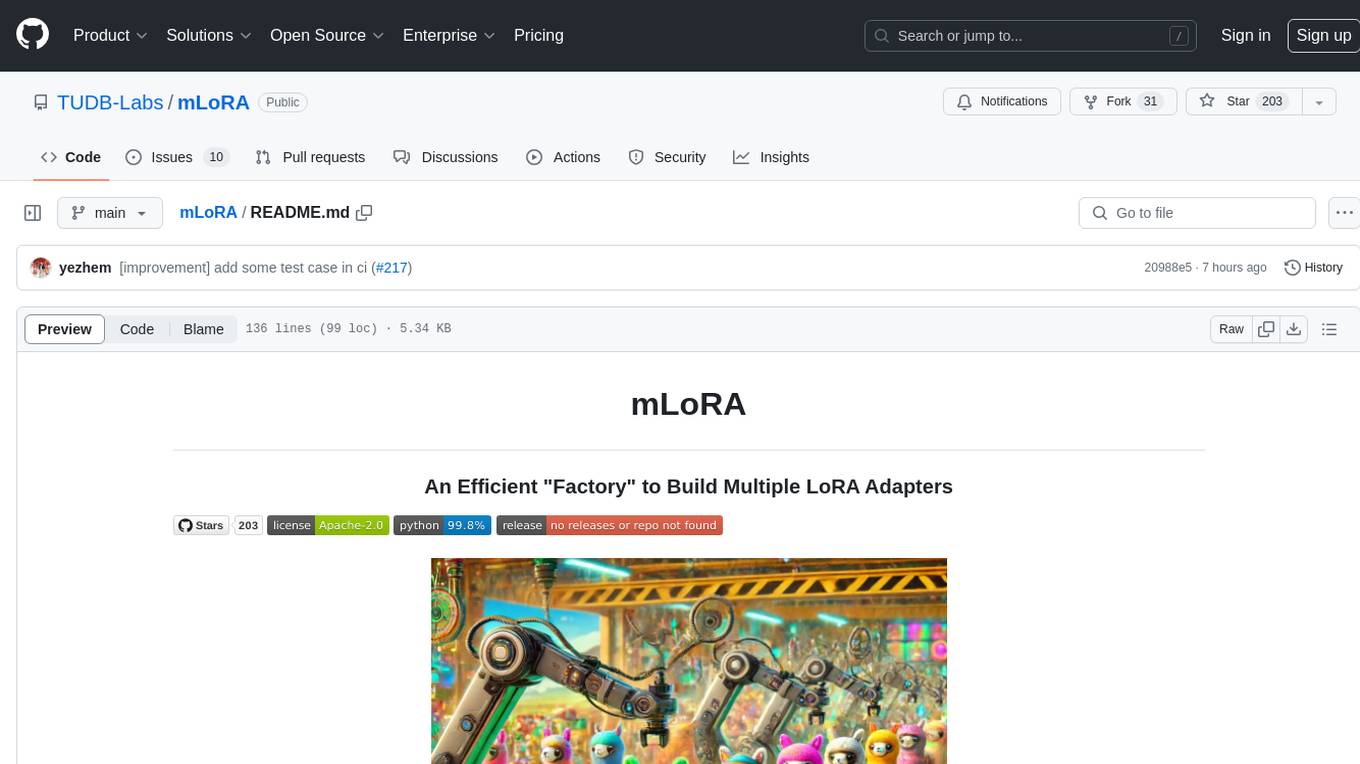
mLoRA
mLoRA (Multi-LoRA Fine-Tune) is an open-source framework for efficient fine-tuning of multiple Large Language Models (LLMs) using LoRA and its variants. It allows concurrent fine-tuning of multiple LoRA adapters with a shared base model, efficient pipeline parallelism algorithm, support for various LoRA variant algorithms, and reinforcement learning preference alignment algorithms. mLoRA helps save computational and memory resources when training multiple adapters simultaneously, achieving high performance on consumer hardware.
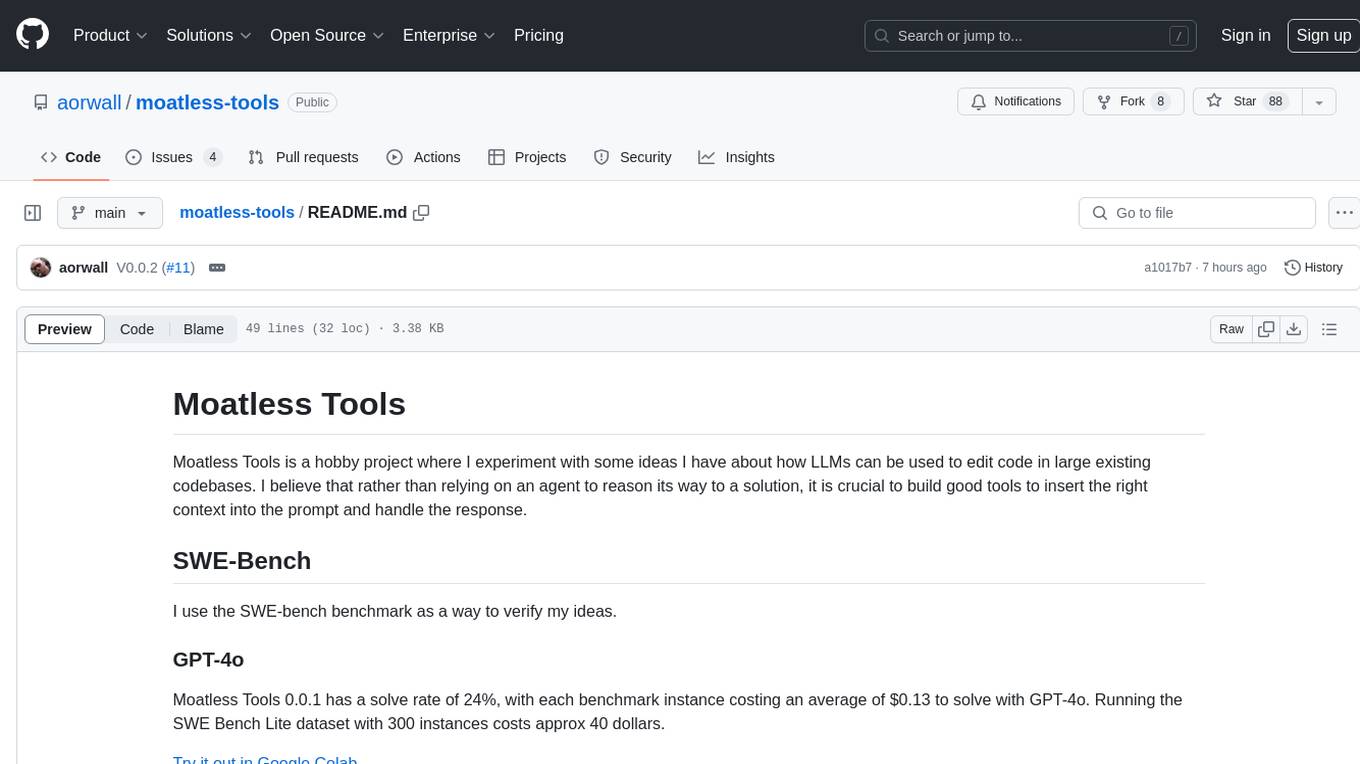
moatless-tools
Moatless Tools is a hobby project focused on experimenting with using Large Language Models (LLMs) to edit code in large existing codebases. The project aims to build tools that insert the right context into prompts and handle responses effectively. It utilizes an agentic loop functioning as a finite state machine to transition between states like Search, Identify, PlanToCode, ClarifyChange, and EditCode for code editing tasks.
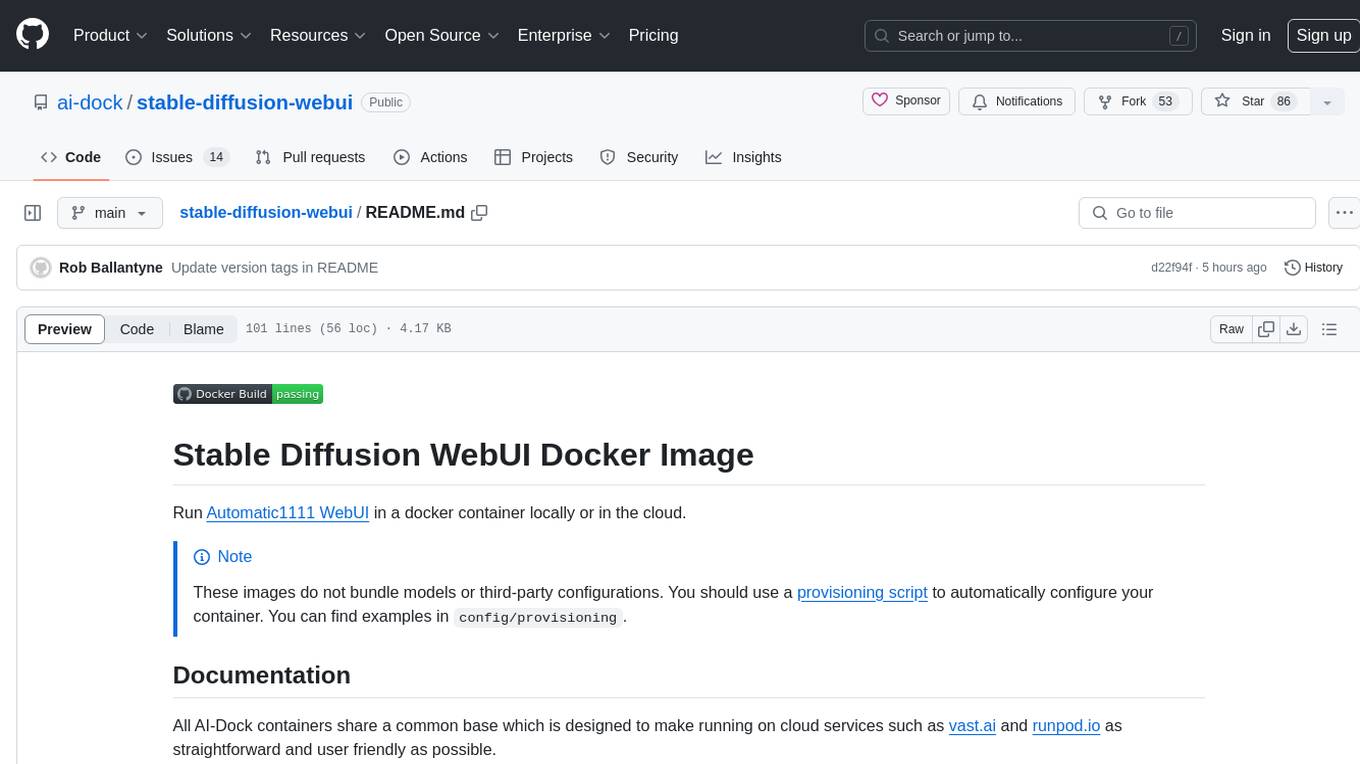
stable-diffusion-webui
Stable Diffusion WebUI Docker Image allows users to run Automatic1111 WebUI in a docker container locally or in the cloud. The images do not bundle models or third-party configurations, requiring users to use a provisioning script for container configuration. It supports NVIDIA CUDA, AMD ROCm, and CPU platforms, with additional environment variables for customization and pre-configured templates for Vast.ai and Runpod.io. The service is password protected by default, with options for version pinning, startup flags, and service management using supervisorctl.
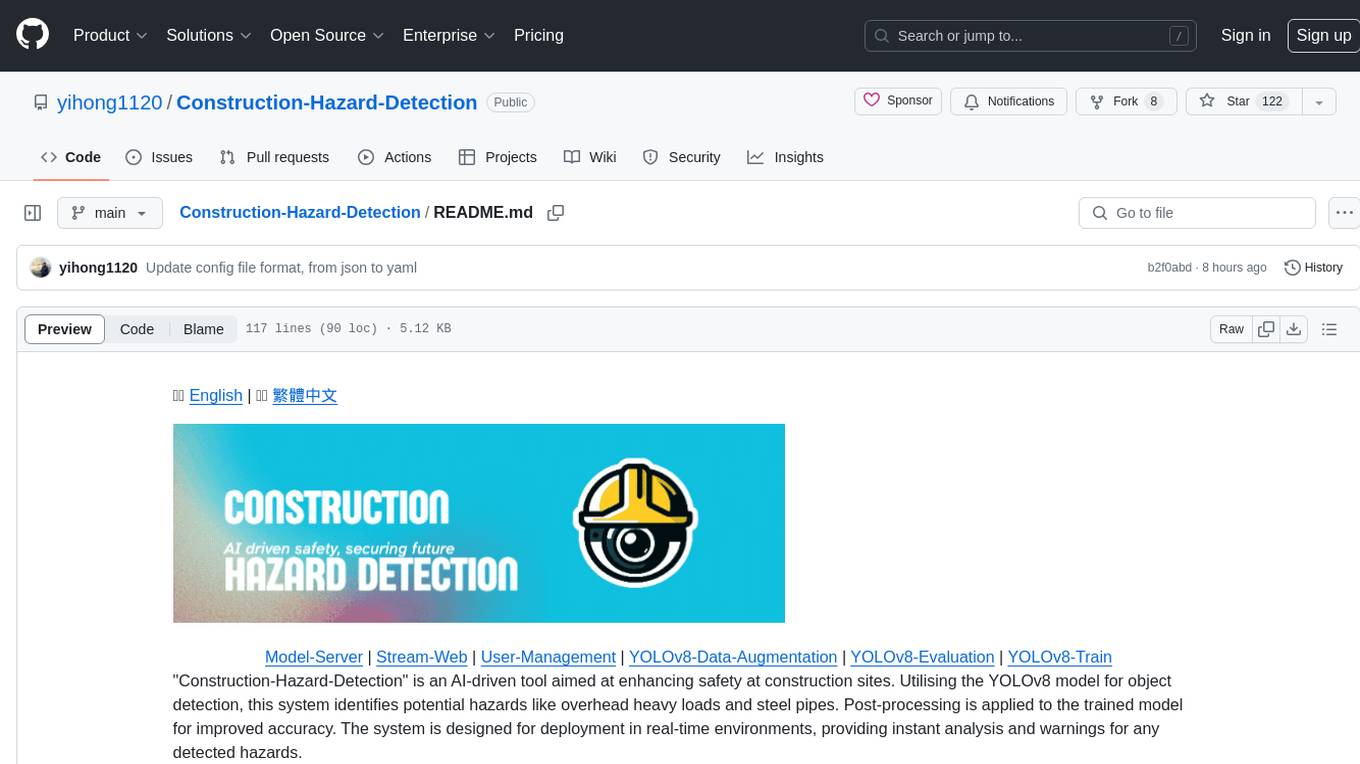
Construction-Hazard-Detection
Construction-Hazard-Detection is an AI-driven tool focused on improving safety at construction sites by utilizing the YOLOv8 model for object detection. The system identifies potential hazards like overhead heavy loads and steel pipes, providing real-time analysis and warnings. Users can configure the system via a YAML file and run it using Docker. The primary dataset used for training is the Construction Site Safety Image Dataset enriched with additional annotations. The system logs are accessible within the Docker container for debugging, and notifications are sent through the LINE messaging API when hazards are detected.
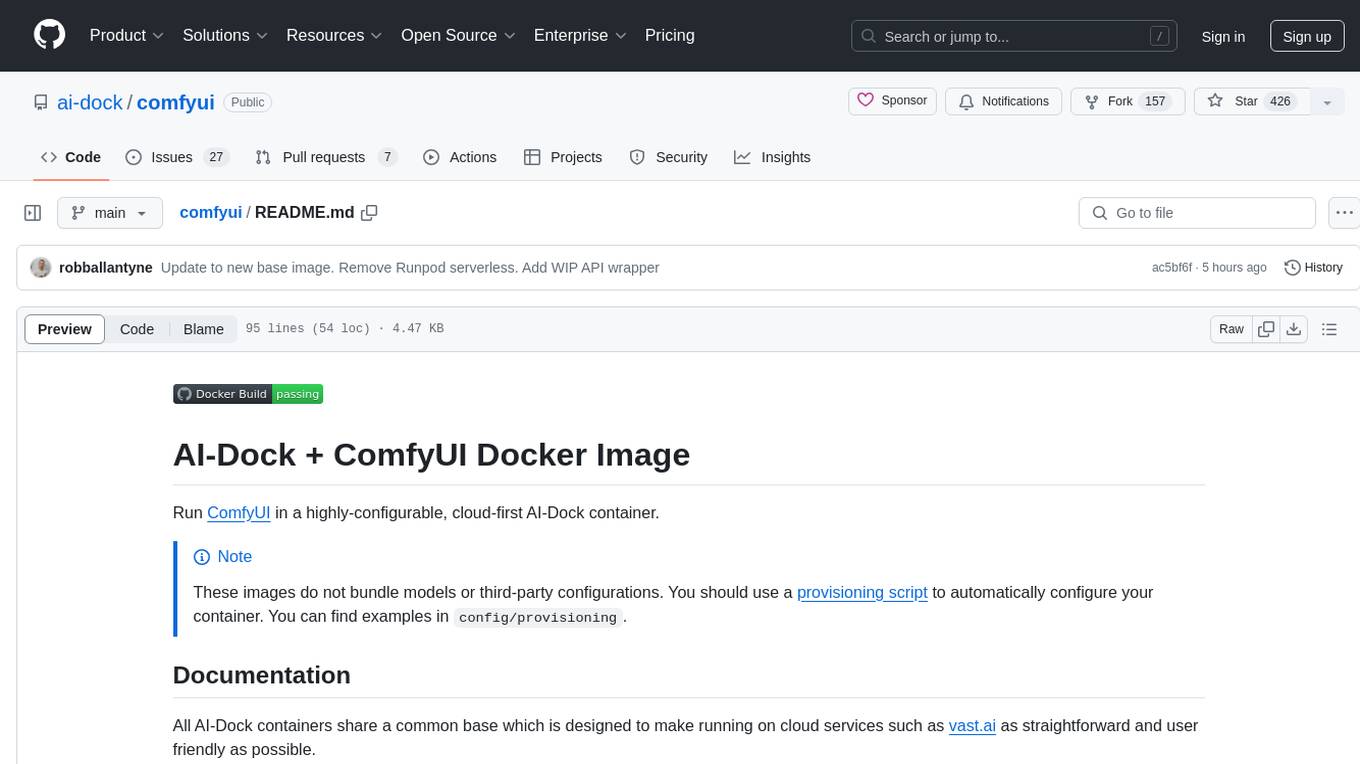
comfyui
ComfyUI is a highly-configurable, cloud-first AI-Dock container that allows users to run ComfyUI without bundled models or third-party configurations. Users can configure the container using provisioning scripts. The Docker image supports NVIDIA CUDA, AMD ROCm, and CPU platforms, with version tags for different configurations. Additional environment variables and Python environments are provided for customization. ComfyUI service runs on port 8188 and can be managed using supervisorctl. The tool also includes an API wrapper service and pre-configured templates for Vast.ai. The author may receive compensation for services linked in the documentation.
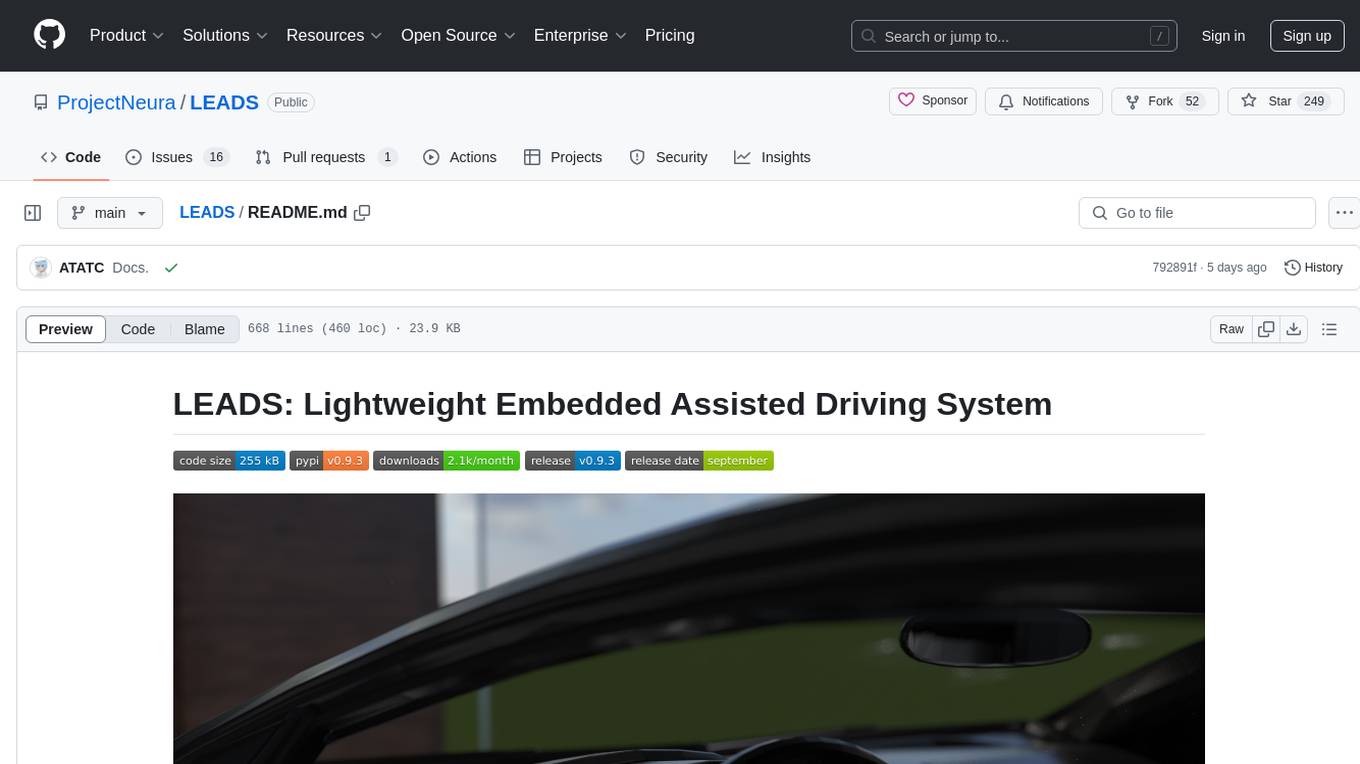
LEADS
LEADS is a lightweight embedded assisted driving system designed to simplify the development of instrumentation, control, and analysis systems for racing cars. It is written in Python and C/C++ with impressive performance. The system is customizable and provides abstract layers for component rearrangement. It supports hardware components like Raspberry Pi and Arduino, and can adapt to various hardware types. LEADS offers a modular structure with a focus on flexibility and lightweight design. It includes robust safety features, modern GUI design with dark mode support, high performance on different platforms, and powerful ESC systems for traction control and braking. The system also supports real-time data sharing, live video streaming, and AI-enhanced data analysis for driver training. LEADS VeC Remote Analyst enables transparency between the driver and pit crew, allowing real-time data sharing and analysis. The system is designed to be user-friendly, adaptable, and efficient for racing car development.
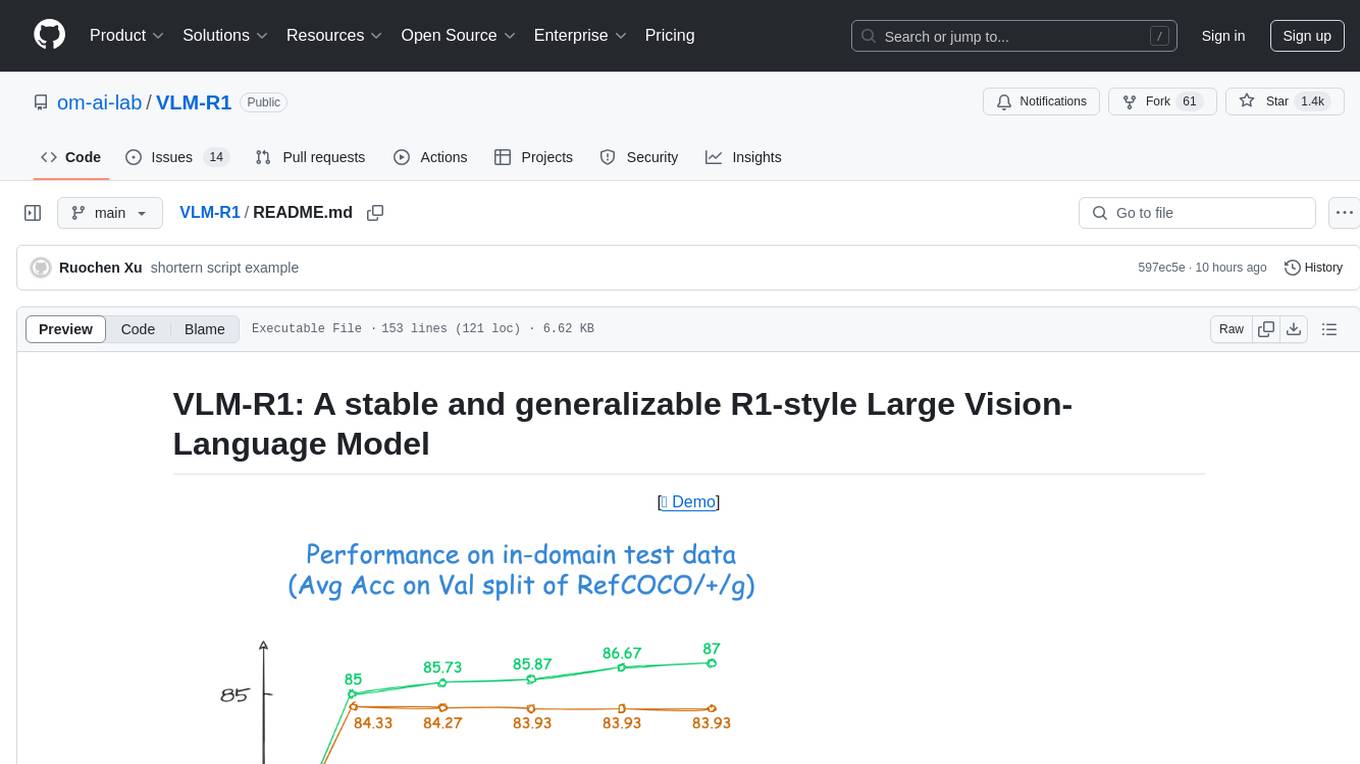
VLM-R1
VLM-R1 is a stable and generalizable R1-style Large Vision-Language Model proposed for Referring Expression Comprehension (REC) task. It compares R1 and SFT approaches, showing R1 model's steady improvement on out-of-domain test data. The project includes setup instructions, training steps for GRPO and SFT models, support for user data loading, and evaluation process. Acknowledgements to various open-source projects and resources are mentioned. The project aims to provide a reliable and versatile solution for vision-language tasks.
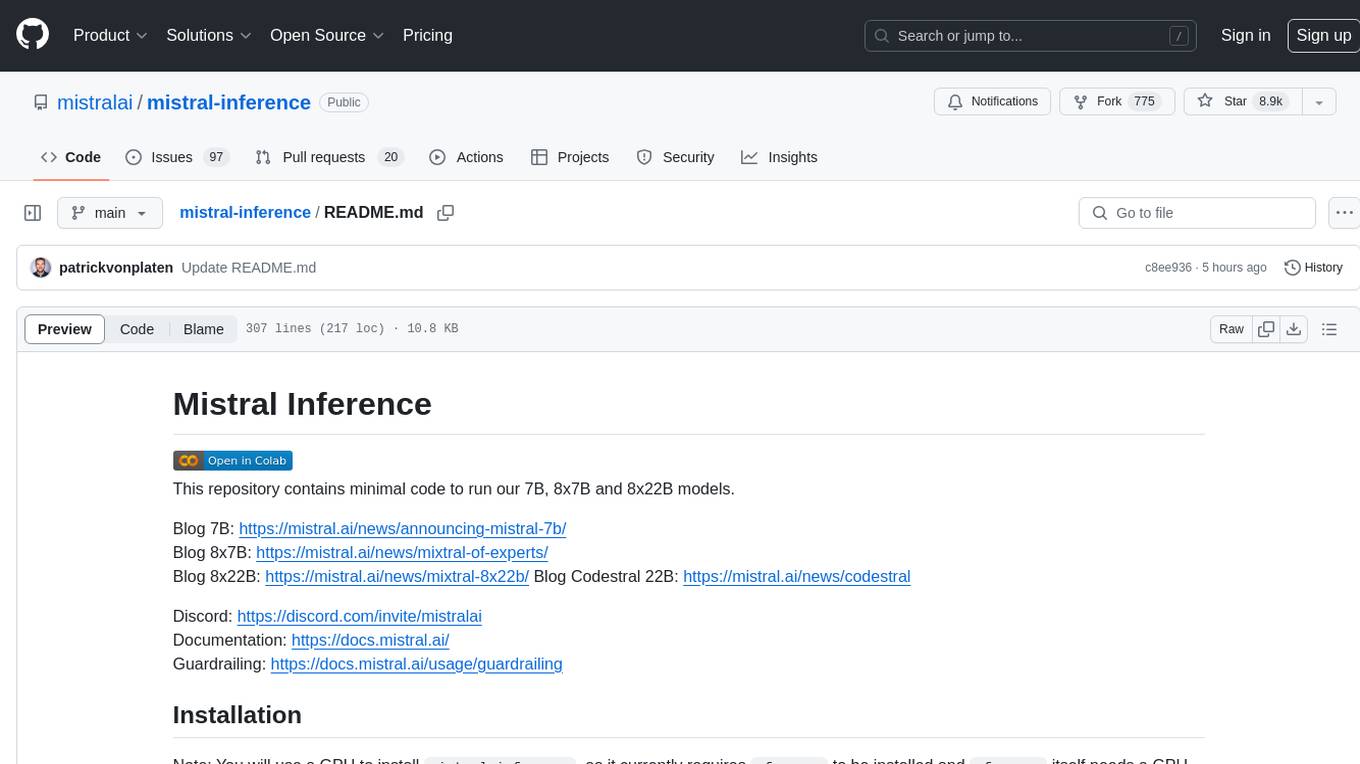
mistral-inference
Mistral Inference repository contains minimal code to run 7B, 8x7B, and 8x22B models. It provides model download links, installation instructions, and usage guidelines for running models via CLI or Python. The repository also includes information on guardrailing, model platforms, deployment, and references. Users can interact with models through commands like mistral-demo, mistral-chat, and mistral-common. Mistral AI models support function calling and chat interactions for tasks like testing models, chatting with models, and using Codestral as a coding assistant. The repository offers detailed documentation and links to blogs for further information.
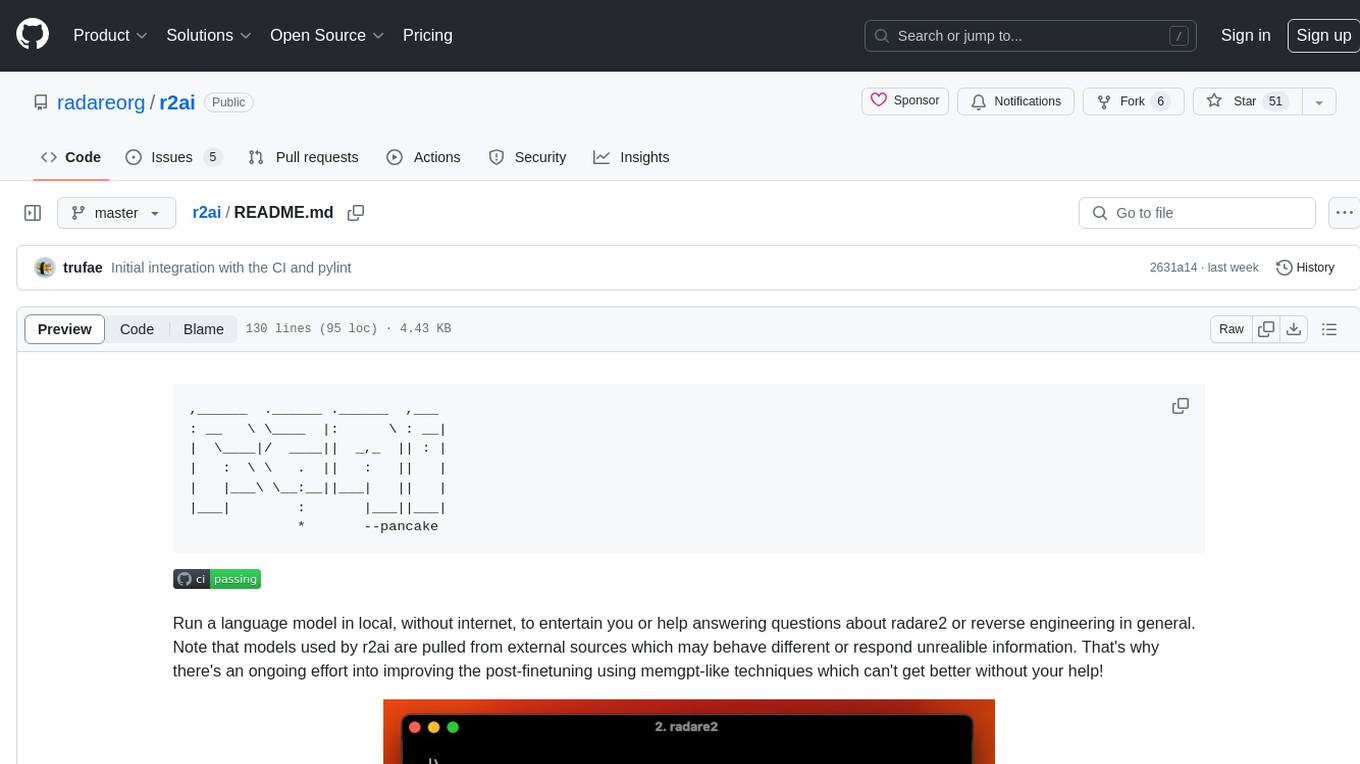
r2ai
r2ai is a tool designed to run a language model locally without internet access. It can be used to entertain users or assist in answering questions related to radare2 or reverse engineering. The tool allows users to prompt the language model, index large codebases, slurp file contents, embed the output of an r2 command, define different system-level assistant roles, set environment variables, and more. It is accessible as an r2lang-python plugin and can be scripted from various languages. Users can use different models, adjust query templates dynamically, load multiple models, and make them communicate with each other.
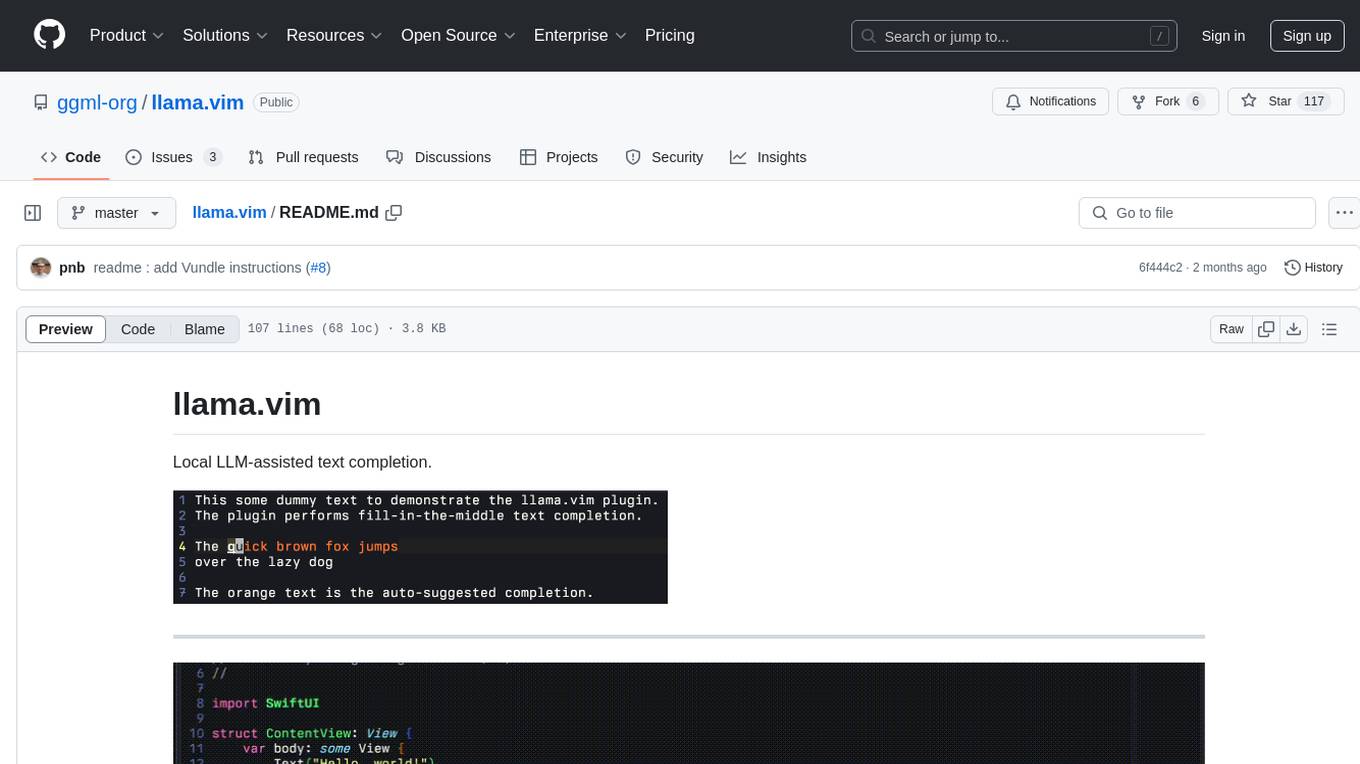
llama.vim
llama.vim is a plugin that provides local LLM-assisted text completion for Vim users. It offers features such as auto-suggest on cursor movement, manual suggestion toggling, suggestion acceptance with Tab and Shift+Tab, control over text generation time, context configuration, ring context with chunks from open and edited files, and performance stats display. The plugin requires a llama.cpp server instance to be running and supports FIM-compatible models. It aims to be simple, lightweight, and provide high-quality and performant local FIM completions even on consumer-grade hardware.
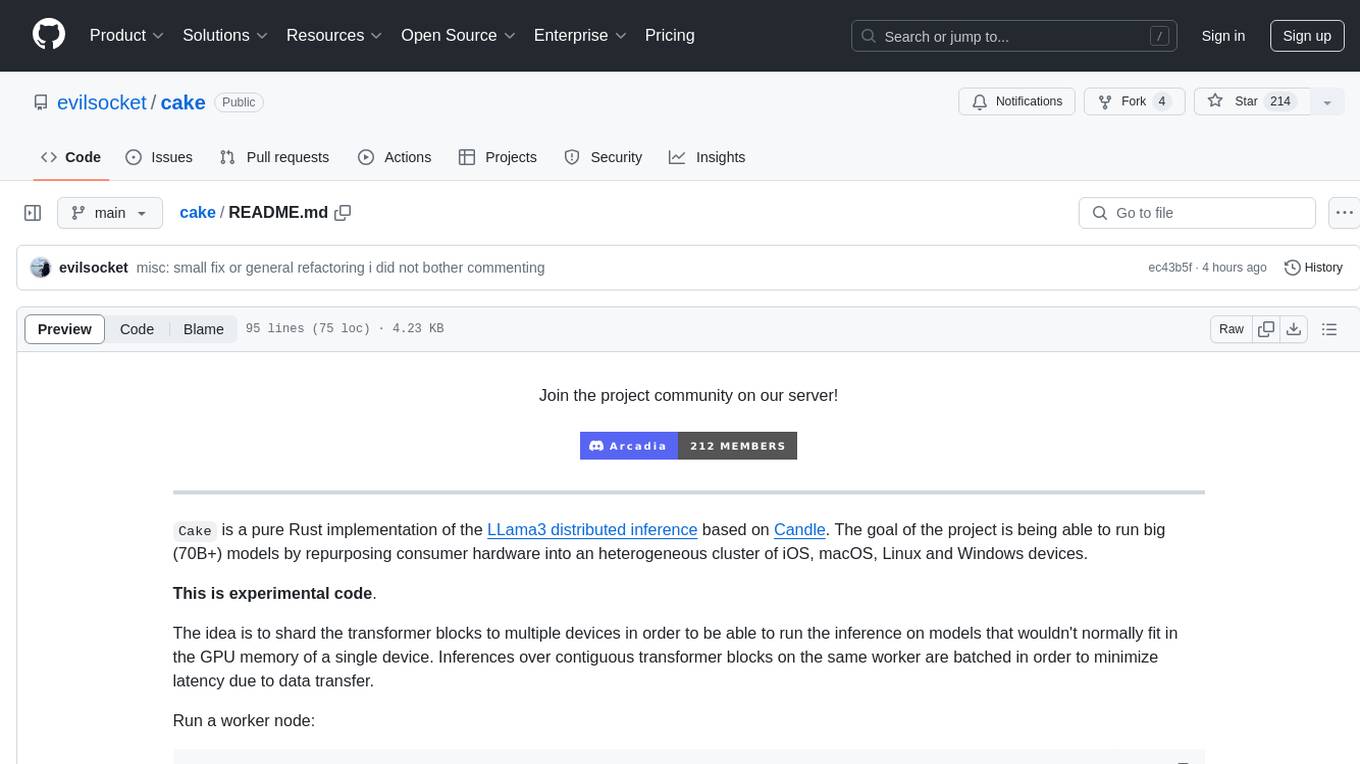
cake
cake is a pure Rust implementation of the llama3 LLM distributed inference based on Candle. The project aims to enable running large models on consumer hardware clusters of iOS, macOS, Linux, and Windows devices by sharding transformer blocks. It allows running inferences on models that wouldn't fit in a single device's GPU memory by batching contiguous transformer blocks on the same worker to minimize latency. The tool provides a way to optimize memory and disk space by splitting the model into smaller bundles for workers, ensuring they only have the necessary data. cake supports various OS, architectures, and accelerations, with different statuses for each configuration.
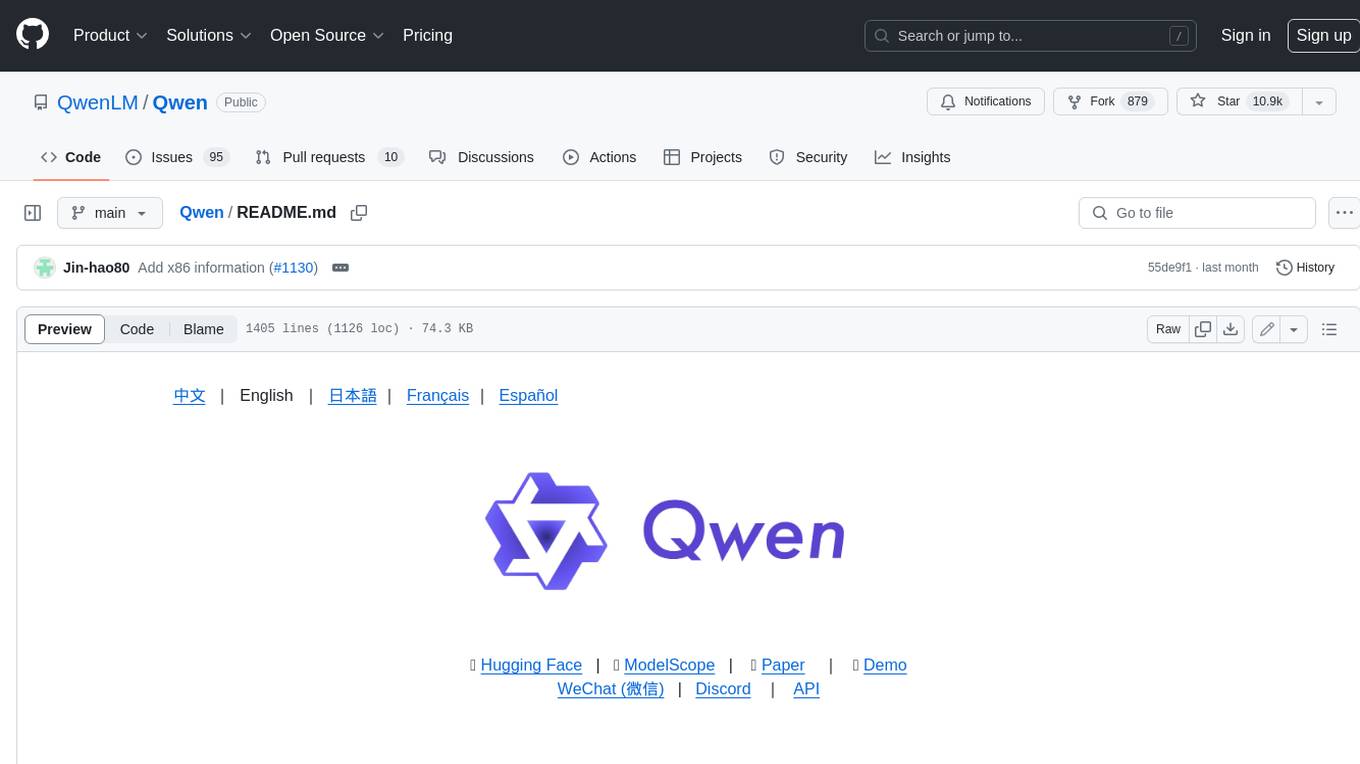
Qwen
Qwen is a series of large language models developed by Alibaba DAMO Academy. It outperforms the baseline models of similar model sizes on a series of benchmark datasets, e.g., MMLU, C-Eval, GSM8K, MATH, HumanEval, MBPP, BBH, etc., which evaluate the models’ capabilities on natural language understanding, mathematic problem solving, coding, etc. Qwen models outperform the baseline models of similar model sizes on a series of benchmark datasets, e.g., MMLU, C-Eval, GSM8K, MATH, HumanEval, MBPP, BBH, etc., which evaluate the models’ capabilities on natural language understanding, mathematic problem solving, coding, etc. Qwen-72B achieves better performance than LLaMA2-70B on all tasks and outperforms GPT-3.5 on 7 out of 10 tasks.
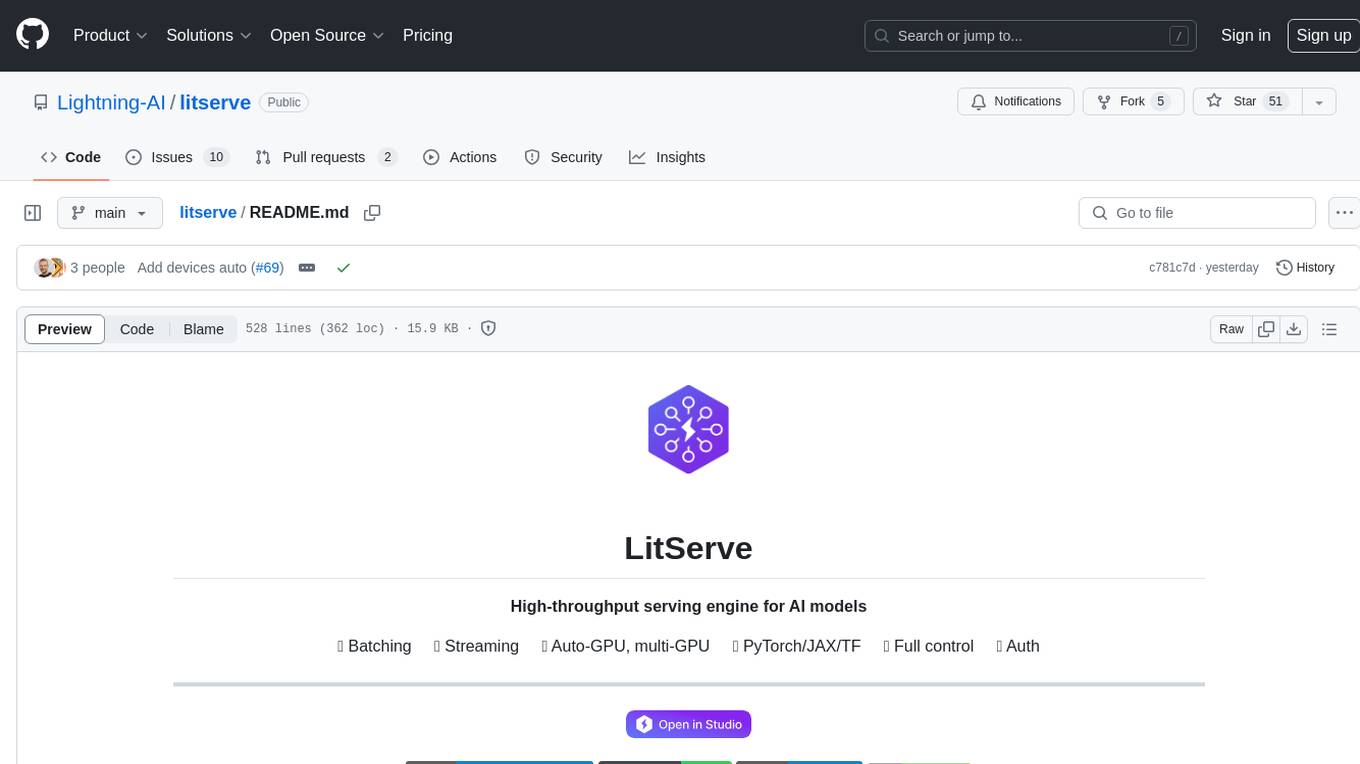
litserve
LitServe is a high-throughput serving engine for deploying AI models at scale. It generates an API endpoint for a model, handles batching, streaming, autoscaling across CPU/GPUs, and more. Built for enterprise scale, it supports every framework like PyTorch, JAX, Tensorflow, and more. LitServe is designed to let users focus on model performance, not the serving boilerplate. It is like PyTorch Lightning for model serving but with broader framework support and scalability.
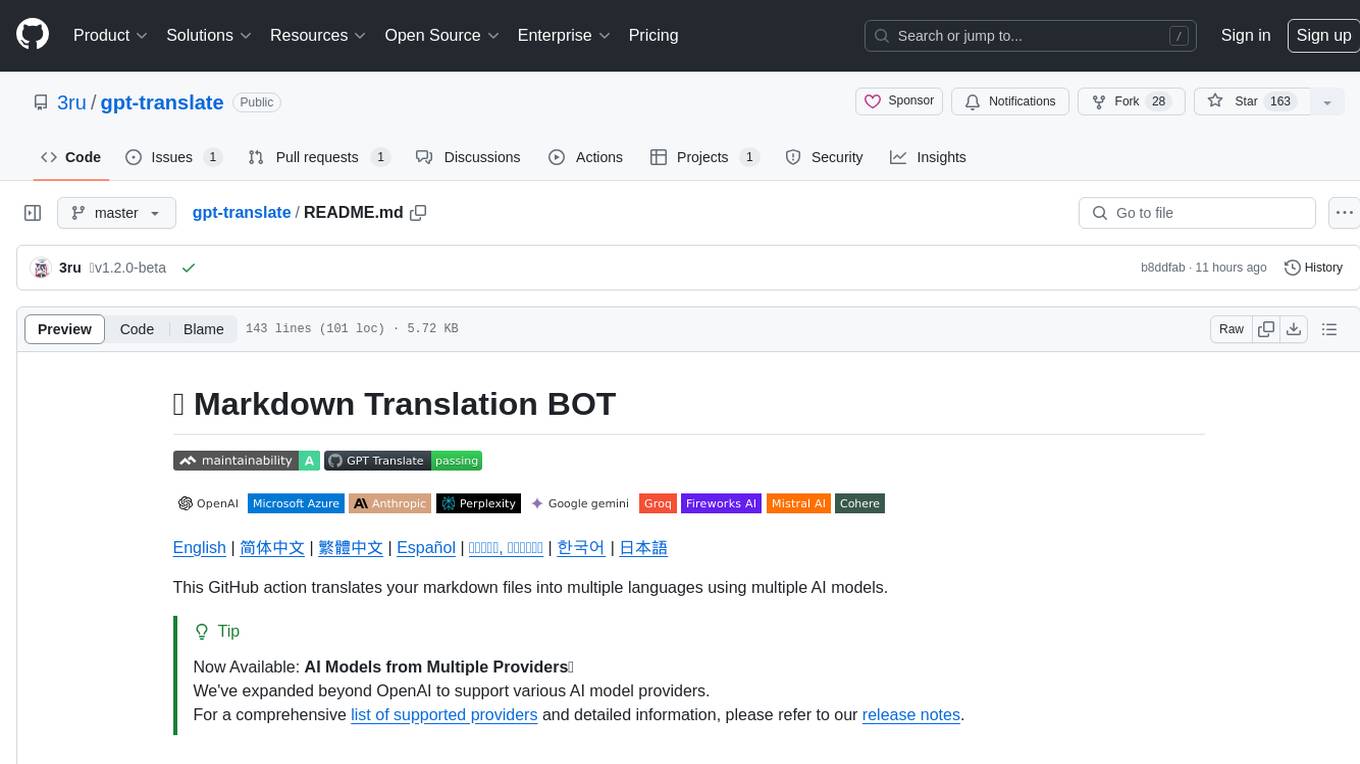
gpt-translate
Markdown Translation BOT is a GitHub action that translates markdown files into multiple languages using various AI models. It supports markdown, markdown-jsx, and json files only. The action can be executed by individuals with write permissions to the repository, preventing API abuse by non-trusted parties. Users can set up the action by providing their API key and configuring the workflow settings. The tool allows users to create comments with specific commands to trigger translations and automatically generate pull requests or add translated files to existing pull requests. It supports multiple file translations and can interpret any language supported by GPT-4 or GPT-3.5.
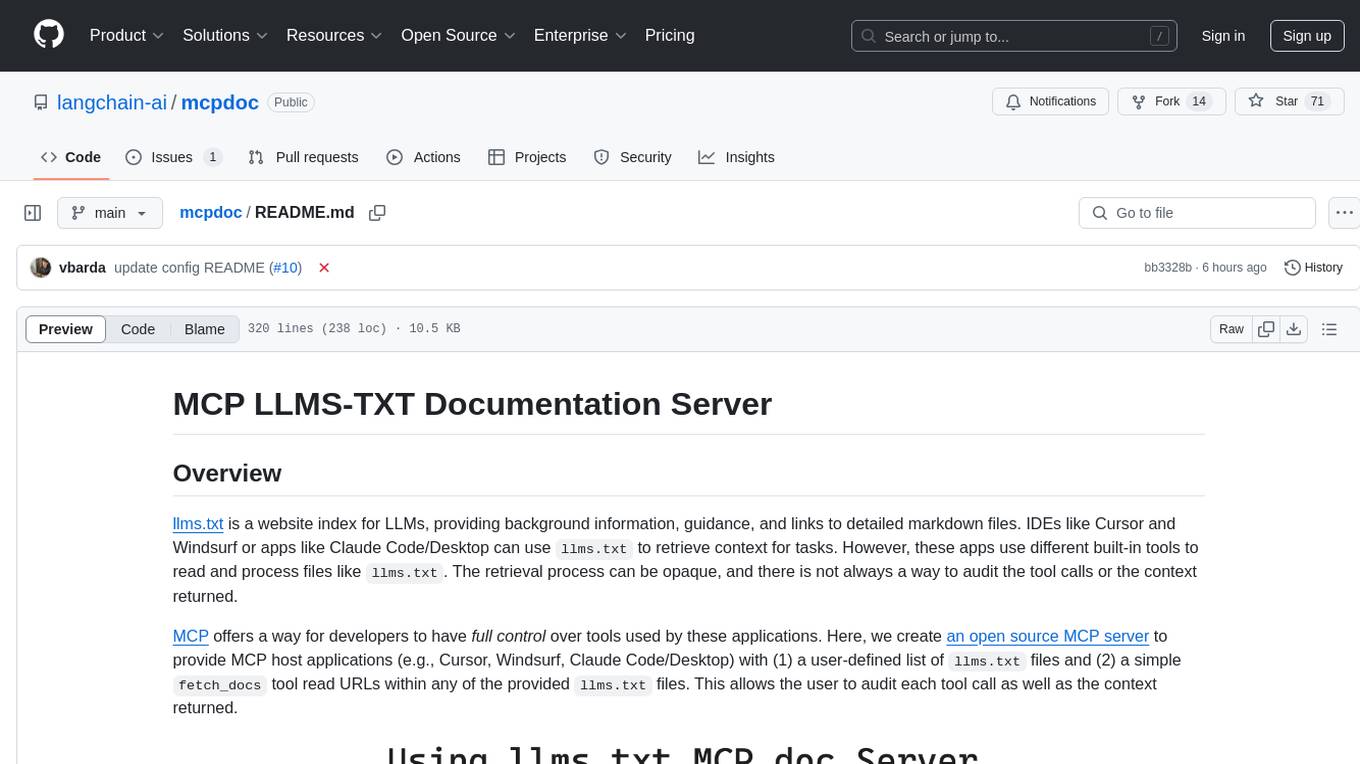
mcpdoc
The MCP LLMS-TXT Documentation Server is an open-source server that provides developers full control over tools used by applications like Cursor, Windsurf, and Claude Code/Desktop. It allows users to create a user-defined list of `llms.txt` files and use a `fetch_docs` tool to read URLs within these files, enabling auditing of tool calls and context returned. The server supports various applications and provides a way to connect to them, configure rules, and test tool calls for tasks related to documentation retrieval and processing.
For similar tasks
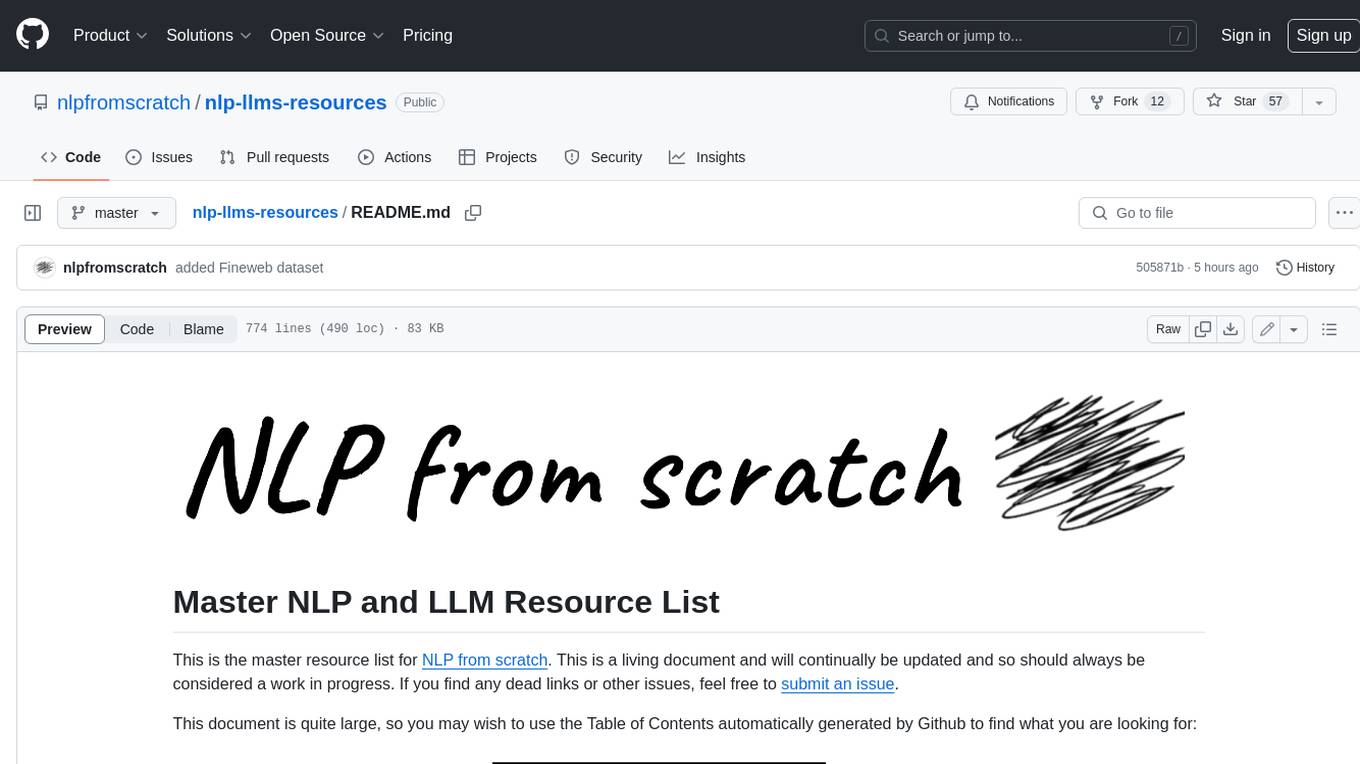
nlp-llms-resources
The 'nlp-llms-resources' repository is a comprehensive resource list for Natural Language Processing (NLP) and Large Language Models (LLMs). It covers a wide range of topics including traditional NLP datasets, data acquisition, libraries for NLP, neural networks, sentiment analysis, optical character recognition, information extraction, semantics, topic modeling, multilingual NLP, domain-specific LLMs, vector databases, ethics, costing, books, courses, surveys, aggregators, newsletters, papers, conferences, and societies. The repository provides valuable information and resources for individuals interested in NLP and LLMs.
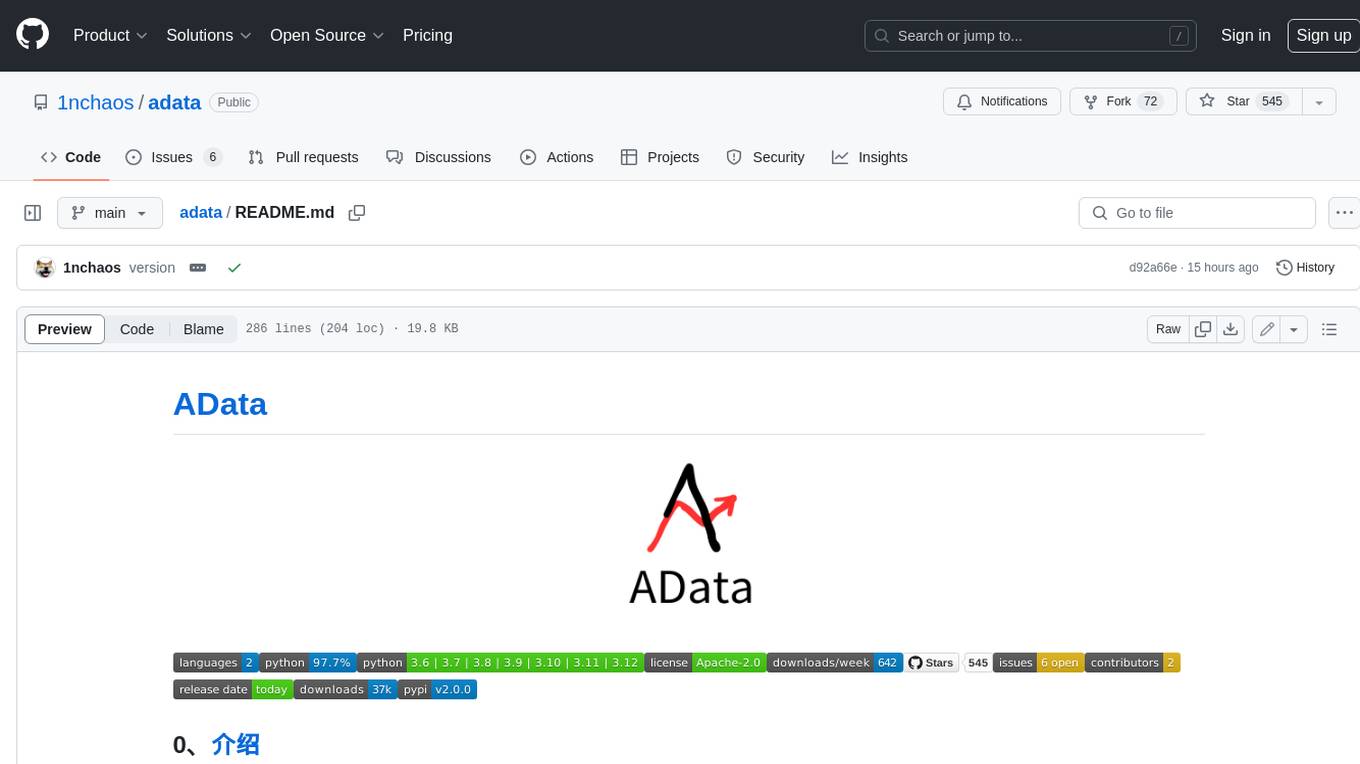
adata
AData is a free and open-source A-share database that focuses on transaction-related data. It provides comprehensive data on stocks, including basic information, market data, and sentiment analysis. AData is designed to be easy to use and integrate with other applications, making it a valuable tool for quantitative trading and AI training.

PIXIU
PIXIU is a project designed to support the development, fine-tuning, and evaluation of Large Language Models (LLMs) in the financial domain. It includes components like FinBen, a Financial Language Understanding and Prediction Evaluation Benchmark, FIT, a Financial Instruction Dataset, and FinMA, a Financial Large Language Model. The project provides open resources, multi-task and multi-modal financial data, and diverse financial tasks for training and evaluation. It aims to encourage open research and transparency in the financial NLP field.
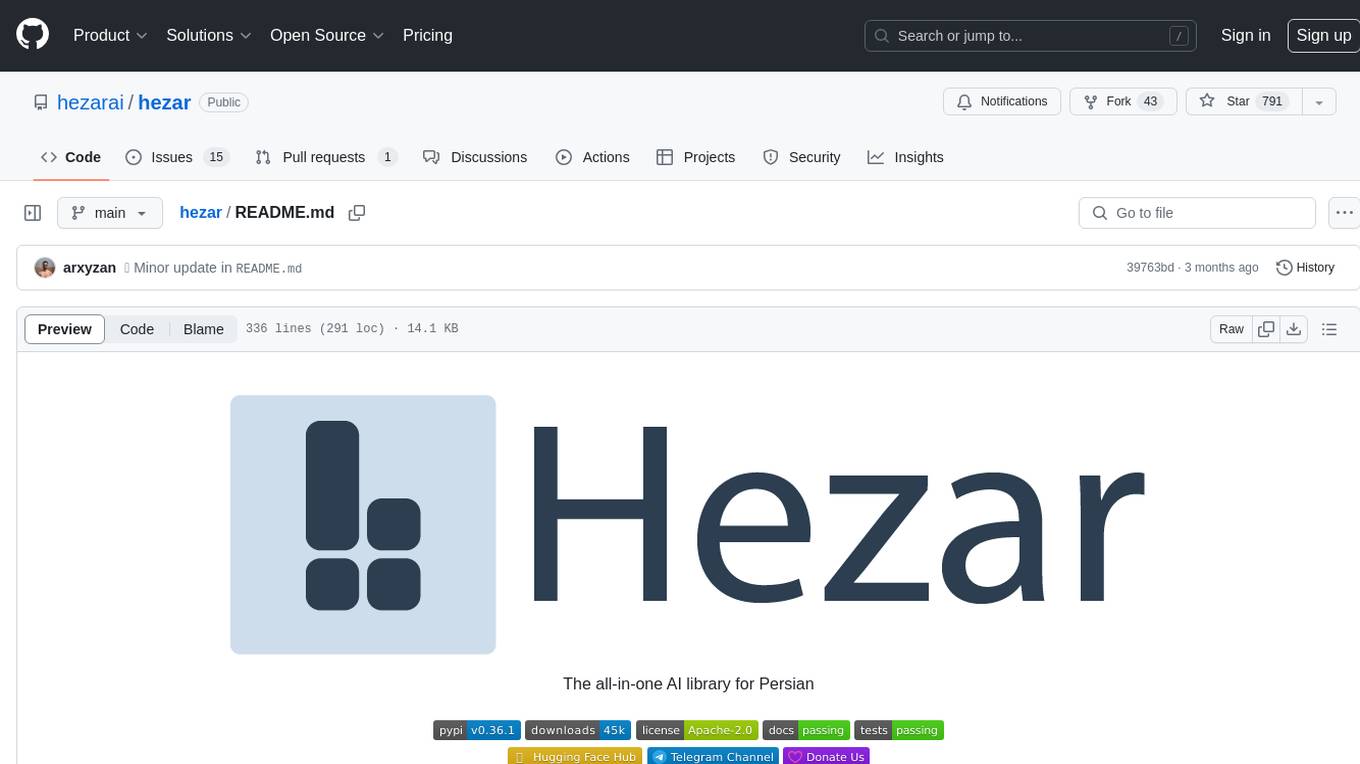
hezar
Hezar is an all-in-one AI library designed specifically for the Persian community. It brings together various AI models and tools, making it easy to use AI with just a few lines of code. The library seamlessly integrates with Hugging Face Hub, offering a developer-friendly interface and task-based model interface. In addition to models, Hezar provides tools like word embeddings, tokenizers, feature extractors, and more. It also includes supplementary ML tools for deployment, benchmarking, and optimization.

text-embeddings-inference
Text Embeddings Inference (TEI) is a toolkit for deploying and serving open source text embeddings and sequence classification models. TEI enables high-performance extraction for popular models like FlagEmbedding, Ember, GTE, and E5. It implements features such as no model graph compilation step, Metal support for local execution on Macs, small docker images with fast boot times, token-based dynamic batching, optimized transformers code for inference using Flash Attention, Candle, and cuBLASLt, Safetensors weight loading, and production-ready features like distributed tracing with Open Telemetry and Prometheus metrics.
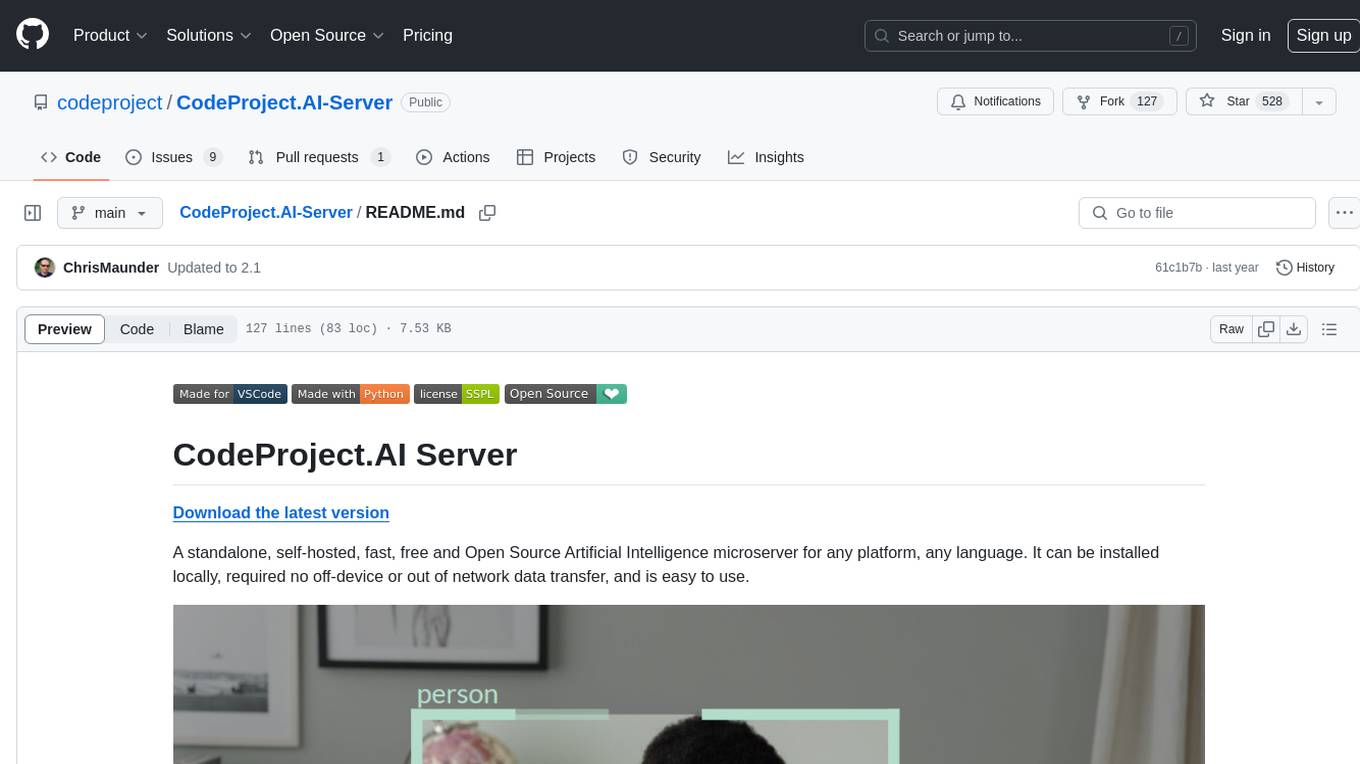
CodeProject.AI-Server
CodeProject.AI Server is a standalone, self-hosted, fast, free, and open-source Artificial Intelligence microserver designed for any platform and language. It can be installed locally without the need for off-device or out-of-network data transfer, providing an easy-to-use solution for developers interested in AI programming. The server includes a HTTP REST API server, backend analysis services, and the source code, enabling users to perform various AI tasks locally without relying on external services or cloud computing. Current capabilities include object detection, face detection, scene recognition, sentiment analysis, and more, with ongoing feature expansions planned. The project aims to promote AI development, simplify AI implementation, focus on core use-cases, and leverage the expertise of the developer community.
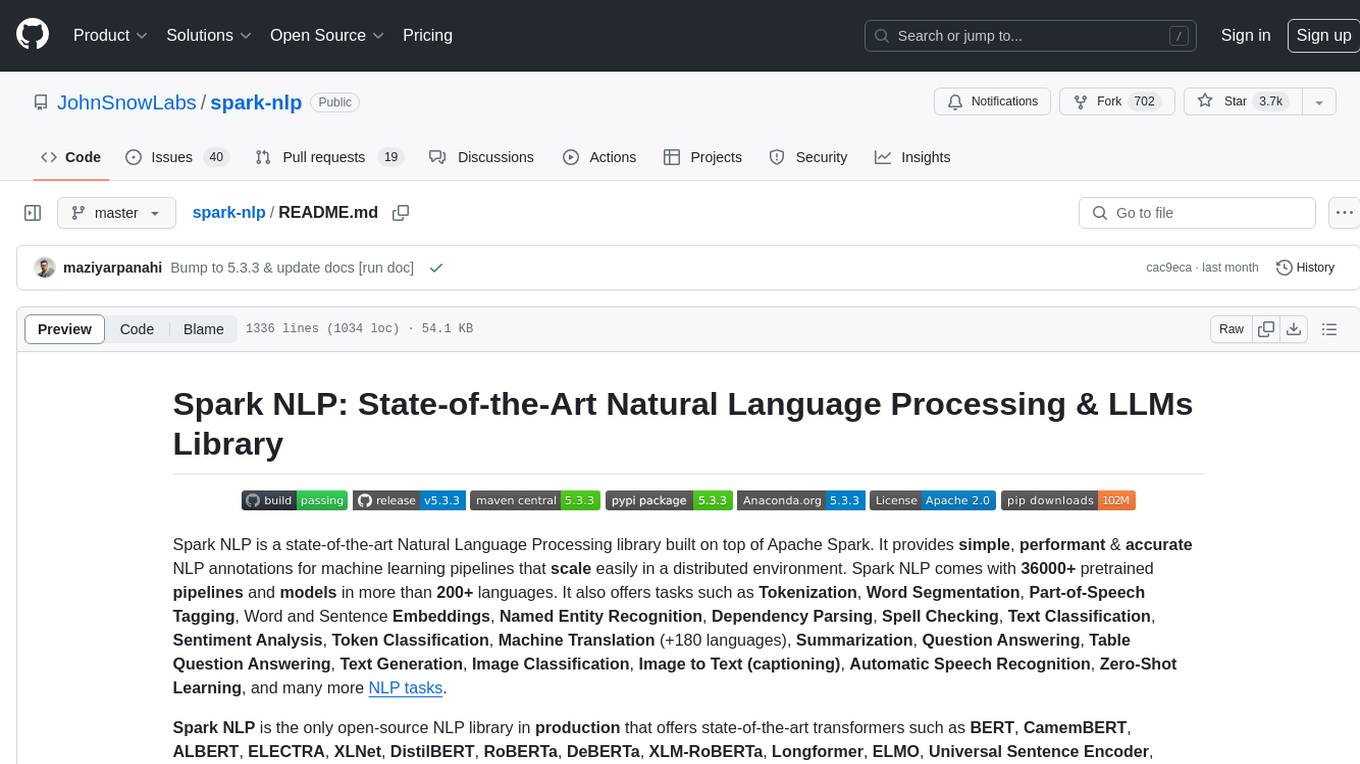
spark-nlp
Spark NLP is a state-of-the-art Natural Language Processing library built on top of Apache Spark. It provides simple, performant, and accurate NLP annotations for machine learning pipelines that scale easily in a distributed environment. Spark NLP comes with 36000+ pretrained pipelines and models in more than 200+ languages. It offers tasks such as Tokenization, Word Segmentation, Part-of-Speech Tagging, Named Entity Recognition, Dependency Parsing, Spell Checking, Text Classification, Sentiment Analysis, Token Classification, Machine Translation, Summarization, Question Answering, Table Question Answering, Text Generation, Image Classification, Image to Text (captioning), Automatic Speech Recognition, Zero-Shot Learning, and many more NLP tasks. Spark NLP is the only open-source NLP library in production that offers state-of-the-art transformers such as BERT, CamemBERT, ALBERT, ELECTRA, XLNet, DistilBERT, RoBERTa, DeBERTa, XLM-RoBERTa, Longformer, ELMO, Universal Sentence Encoder, Llama-2, M2M100, BART, Instructor, E5, Google T5, MarianMT, OpenAI GPT2, Vision Transformers (ViT), OpenAI Whisper, and many more not only to Python and R, but also to JVM ecosystem (Java, Scala, and Kotlin) at scale by extending Apache Spark natively.
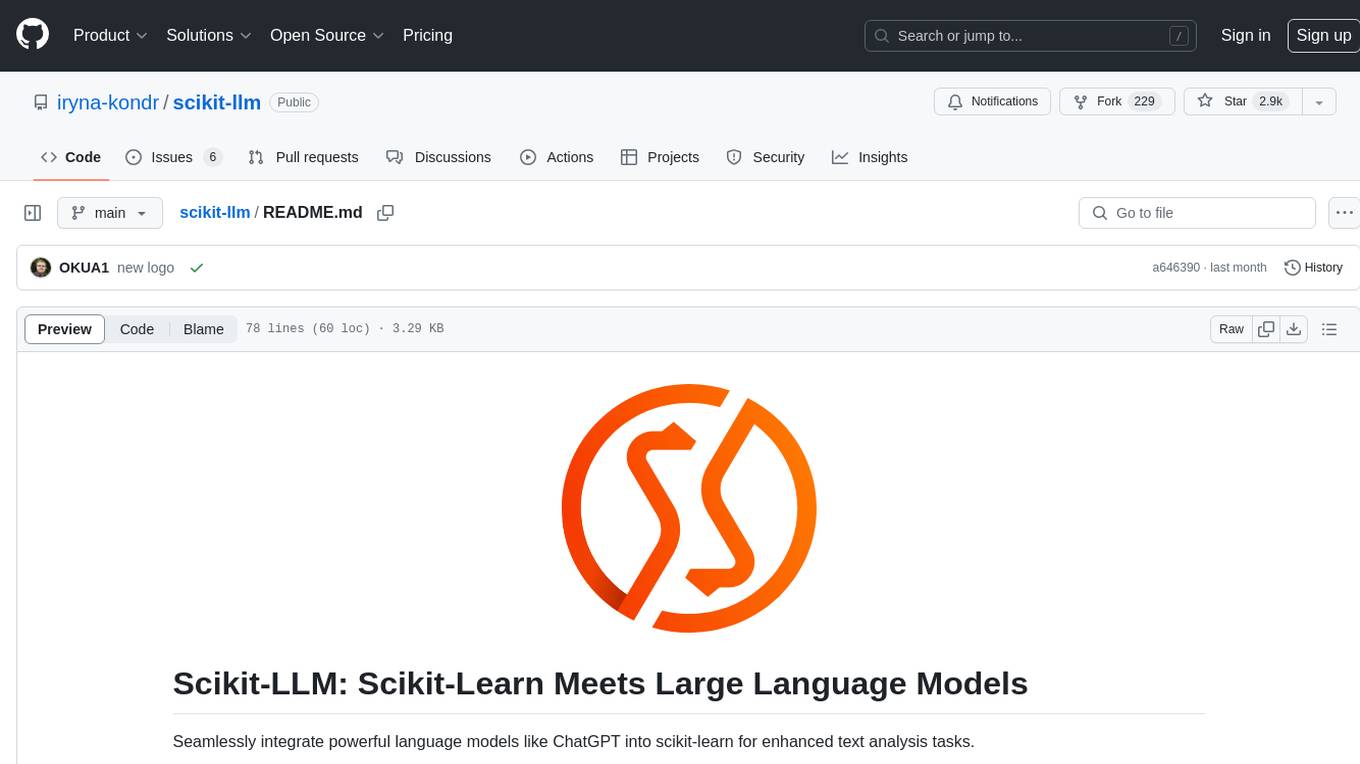
scikit-llm
Scikit-LLM is a tool that seamlessly integrates powerful language models like ChatGPT into scikit-learn for enhanced text analysis tasks. It allows users to leverage large language models for various text analysis applications within the familiar scikit-learn framework. The tool simplifies the process of incorporating advanced language processing capabilities into machine learning pipelines, enabling users to benefit from the latest advancements in natural language processing.
For similar jobs

weave
Weave is a toolkit for developing Generative AI applications, built by Weights & Biases. With Weave, you can log and debug language model inputs, outputs, and traces; build rigorous, apples-to-apples evaluations for language model use cases; and organize all the information generated across the LLM workflow, from experimentation to evaluations to production. Weave aims to bring rigor, best-practices, and composability to the inherently experimental process of developing Generative AI software, without introducing cognitive overhead.

LLMStack
LLMStack is a no-code platform for building generative AI agents, workflows, and chatbots. It allows users to connect their own data, internal tools, and GPT-powered models without any coding experience. LLMStack can be deployed to the cloud or on-premise and can be accessed via HTTP API or triggered from Slack or Discord.

VisionCraft
The VisionCraft API is a free API for using over 100 different AI models. From images to sound.

kaito
Kaito is an operator that automates the AI/ML inference model deployment in a Kubernetes cluster. It manages large model files using container images, avoids tuning deployment parameters to fit GPU hardware by providing preset configurations, auto-provisions GPU nodes based on model requirements, and hosts large model images in the public Microsoft Container Registry (MCR) if the license allows. Using Kaito, the workflow of onboarding large AI inference models in Kubernetes is largely simplified.

PyRIT
PyRIT is an open access automation framework designed to empower security professionals and ML engineers to red team foundation models and their applications. It automates AI Red Teaming tasks to allow operators to focus on more complicated and time-consuming tasks and can also identify security harms such as misuse (e.g., malware generation, jailbreaking), and privacy harms (e.g., identity theft). The goal is to allow researchers to have a baseline of how well their model and entire inference pipeline is doing against different harm categories and to be able to compare that baseline to future iterations of their model. This allows them to have empirical data on how well their model is doing today, and detect any degradation of performance based on future improvements.

tabby
Tabby is a self-hosted AI coding assistant, offering an open-source and on-premises alternative to GitHub Copilot. It boasts several key features: * Self-contained, with no need for a DBMS or cloud service. * OpenAPI interface, easy to integrate with existing infrastructure (e.g Cloud IDE). * Supports consumer-grade GPUs.

spear
SPEAR (Simulator for Photorealistic Embodied AI Research) is a powerful tool for training embodied agents. It features 300 unique virtual indoor environments with 2,566 unique rooms and 17,234 unique objects that can be manipulated individually. Each environment is designed by a professional artist and features detailed geometry, photorealistic materials, and a unique floor plan and object layout. SPEAR is implemented as Unreal Engine assets and provides an OpenAI Gym interface for interacting with the environments via Python.

Magick
Magick is a groundbreaking visual AIDE (Artificial Intelligence Development Environment) for no-code data pipelines and multimodal agents. Magick can connect to other services and comes with nodes and templates well-suited for intelligent agents, chatbots, complex reasoning systems and realistic characters.



